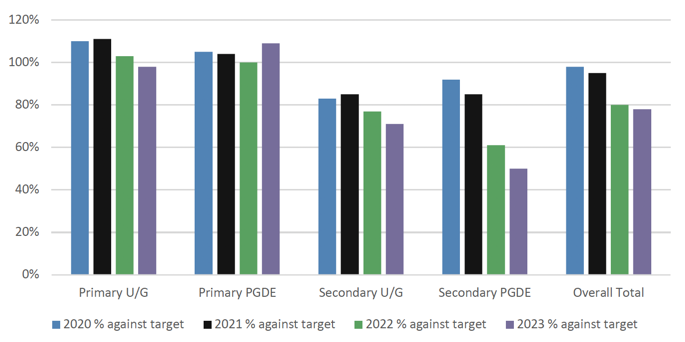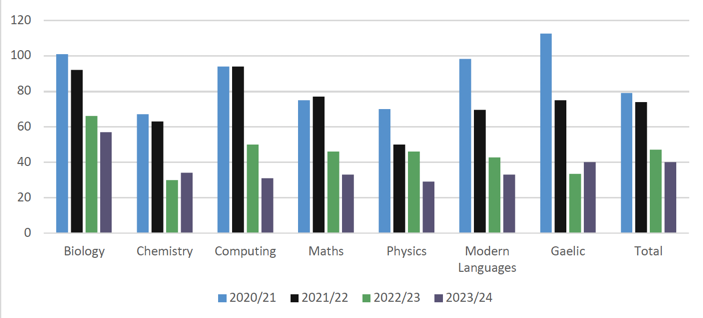Strategic Board for Teacher Education: Meeting 28 Thursday 21 March 2024 2.00pm – 3.30pm
Strategic Board for Teacher Education papers from Thursday 21 March 2024
Workstream 1 Paper for SBTE – 21 March 2023
Workforce Planning and Increasing Diversity of the Profession
COSLA & Scottish Government
Purpose
1. To provide a reminder of the background and context for Workstream 1 (WS1), set out action taken to date and facilitate a discussion on planned next steps.
Context
2. SBTE members presented a paper at the Scottish Education Council in April 2023, which proposed key priorities requiring collective action from partners across the education sector. These are shown in Annex A and included:
- Priority 1 – Increased Resource Demand Analysis
- Priority 2 – Reducing Barriers to Becoming a Teacher
3. Following discussion at the SBTE workshop in September, these two priorities were merged into the following workstream and outcome to be led by COSLA and SG:
Workstream 1: Workforce Planning and Increasing Diversity of the Profession
Outcome: Local and national teacher resource demands are better understood to improve longer-term workforce planning. This includes tackling geographical challenges and ensuring targets for ITE programmes are set and met accordingly, particularly at secondary level and for hard to fill subjects such as science, technologies, mathematics, modern languages and Gaelic. The barriers to individuals with protected characteristics such as race, religion or disability entering or staying in the teaching profession are better understood and reduced.
The possible actions for this workstream are shown in Annex B.
Workforce Planning
4. To understand what action is required, it is important to highlight how the current position maps against the desired outcome.
ITE Intakes
5. Figure 1 shows percentage of recruitment against targets in Scotland for the various ITE programmes at Scottish Higher Education Institutions (HEIs) since 2020.
6. Figure 1 demonstrates that primary undergraduate, and primary Post-Graduate Diploma in Education (PGDE) targets were achieved or exceeded between 2020 and 2023, with primary undergraduate dropping slightly to 98% in 2023. Secondary undergraduate shows a downward trend, with 71% uptake in 2023 compared to 92% in 2020. Secondary PGDE intakes show a more significant downward trend from 92% in 2020 to 61% in 2022 and 50% in 2023.

7. There are particular challenges in meeting secondary PGDE intake targets in science, technologies, mathematics and modern language subjects, as shown in figure 2. For example, in 2023/24 there was an intake of 33% against target for maths, 33% for modern languages and 40% for Gaelic.

Discussion
8. The Cabinet Secretary for Education & Skills is focussed on reviewing the current teacher workforce planning process. This is with a view to better understanding local workforce requirements and ensuring these are fed into the annual process to set Initial Teacher Education (ITE) intake targets.
9. As a starting point for this work, it would be helpful to have more detail on local approaches to workforce planning across Scotland and consider whether a more consistent approach may be helpful in achieving effective long-term strategic planning. It is important that this exercise acknowledges that each local authority has its own unique challenges and there won't be a one size fits all solution.
10. A key component of this work is to better understand what local data is available on teacher resourcing requirements over the short-to-medium term and what capacity there is to improve the collection and collation of such data.
11. This is with a view to potentially transitioning to a 'bottom-up' workforce planning model, informed by local data and workforce requirements as opposed to the current 'top-down' model used to set ITE intake targets, which is based on factors such as maintaining Pupil Teacher Ratios and teacher numbers, at a national level.
12. Gaining a better insight of workforce planning processes and pressures across the country should also be helpful in understanding teacher shortages in certain geographical areas and in developing strategies to tackle these shortages. It will also be important in planning for the implications of the Scottish Government's proposed reduction to class contact time. External research commissioned by the Cabinet Secretary to look at the impact of population changes on education workforce requirements will also help to inform this process. This research is scheduled to be published in the coming weeks.
Actions / Next Steps
13. SG and COSLA are jointly leading this workstream and have met to scope it out in more detail. There has also been engagement with the ADES to determine what local data on teacher resourcing requirements is already available and whether there is the potential for this data to be collected and collated systematically across all 32 local authorities.
14. This workstream was discussed at the ADES Personnel Network meeting on 8th March. Members described this work as 'imperative' and discussed the benefits this work could bring to workforce planning at a local and national level and help to address issues around recruiting teachers geographically and in hard-to fill subjects. It was agreed that primary workforce planning is more stable but there are significant challenges in secondary.
15. A short-life working group is being formed to provide oversight for this work, including reps from COSLA, SG and the ADES Personnel Network. The first step will be to design a workforce planning data gathering tool to issue for completion by every local authority.
16. The working group will report back to SBTE at its next meeting.
Increasing Diversity of the Teaching Profession
Context
17. A Scottish Government priority is to ensure that we have a teaching profession which reflects the diversity of our communities with the ambition that 4% of teachers identify as coming from black and minority ethnic (BME) backgrounds by 2030. As at 2023 this figure is 1.8% (2.3% in secondary and 1.2% in primary).
18. In 2021-22, 165 or 4.5% of UK-domiciled entrants to ITE programmes at Scottish HEIs came from ethnic minority backgrounds. The proportion of entrants from ethnic minorities was higher on postgraduate courses at 5.2% compared to undergraduate courses at 3.4%.
19. The Scottish Government also supports student teachers to undertake the Catholic Teachers' Certificate (CTC) to ensure a supply of appropriately qualified teachers in denominational schools. A recent analysis by the University of Glasgow and the Scottish Catholic Education Service shows that across Scotland there is a significant number of teachers permanently employed in denominational schools who do not hold the CTC yet are expected to have it. The analysis also shows 156 primary vacancies and 66 secondary vacancies in denominational schools (6% and 3% of the overall staffing complement respectively)
Discussion
20. The Scottish Government's Anti-Racism in Education Programme (AREP) has a workstream dedicated to increasing the racial diversity of the teaching profession by addressing barriers to recruitment, retention and promotion. Work underway which will contribute to that ambition includes: considering effective recruitment practices in local authorities which mitigate the barriers which BME teachers can experience; and working with the SCDE to encourage ITE providers to engage with, and implement, the recommendations in the Council's new anti-racism in ITE framework.
21. Work has also been commissioned to develop an anti-racism framework for education employers, that will act as a support mechanism for LAs in achieving the 2030 target through offering recommended areas for action across the recruitment, retention and progression of BME teachers. This work is being undertaken in collaboration with ADES and is due to conclude in May 2024.
22. SBTE members have been clear that strong links should be made with AREP. Members have also been clear that SBTE should consider all protected characteristics when seeking to increase diversity in the teaching profession and highlighted that there may be learning from the approach taken through AREP that could encourage similar approaches elsewhere.
23. It would be helpful to get views from SBTE members on the proposed diversity actions and consider if a separate sub-group should be formed to progress these actions and, if so, which members would wish to sit on that sub-group.
24. It would also be helpful to receive suggestions from SBTE members on any other areas that could be explored to reduce barriers to becoming a teacher for individuals with protected characteristics.
SBTE Secretariat / COSLA
March 2024
Contact
Email: Scott.brand@gov.scot
There is a problem
Thanks for your feedback